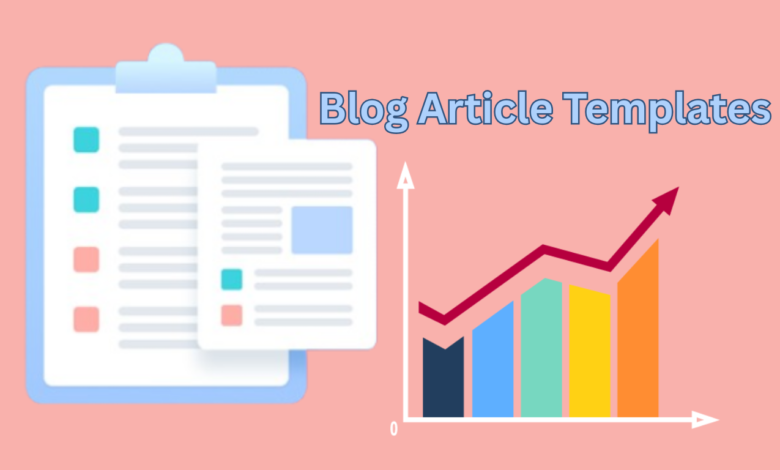Blog Article Templates The Complete Guide to Creating Engaging Content

Writing consistently engaging and professional blog posts is one of the biggest challenges for content creators, marketers, and businesses. Every article needs to be well-structured, SEO-friendly, and appealing to readers. That’s where blog article templates come into play. They provide a roadmap for structuring your content, saving time, and ensuring every post follows a proven formula that works.
In this detailed guide, we’ll cover everything you need to know about blog article templates—from why they matter, how to use them effectively, the most common types, and practical tips for customization. By the end, you’ll have a set of actionable templates you can use to create better blog content that ranks well and keeps readers engaged.
Why Blog Article Templates Are Important
Before diving into specific structures, let’s understand why templates matter in the first place.
1. Consistency Across Posts
Readers love predictability. When your blog posts follow a logical and easy-to-follow format, they feel familiar and trustworthy. Templates allow you to maintain this consistency across multiple articles.
2. Saves Time and Effort
Instead of starting from a blank page every time, templates provide you with a starting point. This eliminates writer’s block and speeds up the content creation process.
3. Enhances SEO
Well-structured blog article templates ensure that important SEO elements like headings, keyword placement, meta descriptions, and call-to-actions are always in the right place.
4. Improves Readability
Templates break content into digestible sections, which improves readability and keeps readers scrolling. In today’s fast-paced digital world, that’s essential for retaining attention.
Elements of Effective Blog Article Templates
Every great template shares some common features. Let’s go through them step by step.
1. Compelling Title
Your blog’s headline should grab attention while incorporating a primary keyword. Example: “10 Blog Article Templates That Will Save You Hours of Work”.
2. Engaging Introduction
The intro sets the tone and explains what readers will learn. It should be conversational and hook the audience immediately.
3. Clear Subheadings (H2 & H3)
Subheadings not only make your content scannable but also help with SEO. Organize your ideas logically using them.
4. Body Content with Value
Each section should provide actionable tips, examples, or explanations. Avoid fluff and focus on value.
5. Conclusion or Wrap-Up
Summarize the key points and provide a call-to-action (CTA), such as subscribing to a newsletter, downloading a resource, or leaving a comment.
Popular Blog Article Templates You Can Use
Here are some of the most effective structures you can apply directly to your writing.
1. Listicle Template
- Title: “X Ways to [Achieve a Goal]”
- Intro: Explain why the topic matters.
- Body: Numbered list of tips, tools, or strategies.
- Conclusion: Wrap-up and encourage the reader to take action.
Example: “15 Blog Article Templates That Will Transform Your Content Strategy”.
2. How-To Guide Template
- Title: “How to [Do Something] in X Steps”
- Intro: Highlight the problem and promise a solution.
- Step 1–X: Break the process down with detailed explanations.
- Conclusion: Summarize and encourage practice.
3. Beginner’s Guide Template
- Title: “The Beginner’s Guide to [Topic]”
- Intro: Welcome newcomers and explain the basics.
- Body: Divide the topic into fundamentals, tips, and resources.
- Conclusion: Suggest advanced learning or next steps.
4. Case Study Template
- Title: “How [Brand/Person] Achieved [Result]”
- Intro: Introduce the subject and why it matters.
- Body: Break down the challenge, solution, and results.
- Conclusion: Share takeaways for the reader.
5. Comparison Post Template
- Title: “X vs. Y: Which is Better for [Audience/Goal]?”
- Intro: Explain why the comparison matters.
- Body: Side-by-side comparison of features, pros, and cons.
- Conclusion: Recommend the best option depending on needs.
6. Review Template
- Title: “Complete Review of [Product/Service] in [Year]”
- Intro: Set expectations.
- Body: Cover features, pricing, pros/cons, and alternatives.
- Conclusion: Give a verdict and recommend action.
7. Thought Leadership Template
- Title: “The Future of [Industry/Trend]”
- Intro: Share an insight or bold statement.
- Body: Provide arguments, data, and expert opinions.
- Conclusion: Wrap up with predictions or action points.
How to Customize Blog Article Templates
Using a template doesn’t mean your content has to look identical to others. Personalization is key.
Add Brand Personality
Infuse your unique voice, tone, and storytelling style. Templates provide the skeleton—you add the muscle.
Mix Content Types
Blend text with visuals, infographics, videos, or interactive elements to keep readers engaged.
SEO Optimization
Always tailor templates for SEO by placing the main keyword, like blog article templates, naturally throughout your post. Ensure it appears in the title, intro, subheadings, and conclusion.
Adapt for Audience
Consider your target readers. A beginner’s guide template works better for newcomers, while case studies resonate with professionals.
Best Practices for Using Blog Article Templates
- Don’t Overstuff Keywords: Mention the main keyword 3–5 times naturally.
- Write for Humans First: Templates help with structure, but always prioritize reader engagement over algorithms.
- Update Regularly: Refresh old content using templates to keep it relevant.
- Use Data and Examples: Enhance credibility by backing up claims.
- Strong CTA: Guide readers to take the next step after finishing your article.
Example: Blog Article Template in Action
Let’s apply a how-to guide template:
Title: How to Write Blog Posts Faster Using Templates
- Intro: Writing blog posts can feel overwhelming, but templates streamline the process.
- Step 1: Choose the right template for your topic.
- Step 2: Fill in the sections with your research and insights.
- Step 3: Edit and optimize for SEO.
- Conclusion: With templates, you save time and deliver consistent results.
FAQs About Blog Article Templates
Q1. What are blog article templates?
They are pre-structured outlines that help writers create consistent, engaging, and SEO-friendly content.
Q2. Why should I use blog article templates?
They save time, ensure consistency, and provide a clear structure for better readability and SEO.
Q3. Can I customize a template?
Yes! Templates are meant to be adapted to your brand voice, style, and audience needs.
Q4. How do blog article templates help with SEO?
They encourage proper keyword placement, logical structure, and readability—all of which improve SEO rankings.
Q5. Where can I find ready-to-use blog article templates?
Many content marketing platforms, writing tools, and guides (like this one) offer free and premium templates.
Conclusion
If you’re struggling to produce consistent, high-quality content, blog article templates are the secret weapon you’ve been missing. They save time, improve readability, and boost SEO—all while giving you the freedom to add your unique voice and creativity. Whether you’re writing listicles, how-to guides, or case studies, having a reliable framework transforms blogging from a chore into a streamlined process.
Start experimenting with different templates today, adapt them to your needs, and watch your content performance grow.



